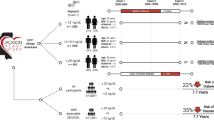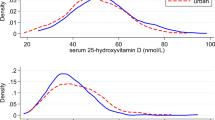Abstract
BACKGROUND/OBJECTIVES:
Mild to moderate vitamin D insufficiency has been proposed as a risk factor for several common chronic diseases including type 2 diabetes. This study aimed to examine the association between serum 25-hydroxy vitamin D (25(OH)D) and incident diabetes.
SUBJECTS/METHODS:
The MONICA10 cohort consists of 2656 participants (men and women aged 41–71 years) who participated in a 10-year follow-up examination during 1993–1994 as part of the MONICA 1 population survey. A total of 2571 participants free of diabetes at baseline and with successful measurement of serum 25(OH)D were included in the current study. The Danish National Diabetes register enabled identification of 288 cases of incident diabetes during follow-up (median: 16.4 years). Data were analysed by Cox proportional hazard models and associations were expressed as hazard ratios (HRs) with 95% confidence intervals (CIs).
RESULTS:
Serum 25(OH)D was inversely associated with incident diabetes adjusted for potential confounders (HR per 25 nmol/l=0.83; 95% CI: 0.72–0.95; P=0.009). A statistically significant interaction was observed between 25(OH)D and waist circumference (WC) (Pinteraction=0.042) suggesting an association in persons with a high WC (HR (95%CI) per 25 nmol/l=0.74 (0.63–0.88), 218 incident cases) and not in persons with a normal WC (HR (95%CI) per 25 nmol/l=0.98 (0.78–1.24), 70 incident cases).
CONCLUSIONS:
Low serum 25(OH)D was associated independently with incident diabetes. The inverse association was only found in overweight-obese and not in normal weight individuals, suggesting that obesity may modify the effect of vitamin D status on the risk of diabetes.
This is a preview of subscription content, access via your institution
Access options
Subscribe to this journal
Receive 12 print issues and online access
$259.00 per year
only $21.58 per issue
Buy this article
- Purchase on Springer Link
- Instant access to full article PDF
Prices may be subject to local taxes which are calculated during checkout

Similar content being viewed by others
References
Holick MF, Chen TC . Vitamin D deficiency: a worldwide problem with health consequences. Am J Clin Nutr 2008; 87: 1080S–1086S.
Brot C, Vestergaard P, Kolthoff N, Gram J, Hermann AP, Sorensen OH . Vitamin D status and its adequacy in healthy Danish perimenopausal women: relationships to dietary intake, sun exposure and serum parathyroid hormone. Br J Nutr 2001; 86: S97–S103.
Webb AR, Kline L, Holick MF . Influence of season and latitude on the cutaneous synthesis of vitamin D3: exposure to winter sunlight in Boston and Edmonton will not promote vitamin D3 synthesis in human skin. J Clin Endocrinol Metab 1988; 67: 373–378.
Thuesen B, Husemoen L, Fenger M, Jakobsen J, Schwarz P, Toft U et al. Determinants of vitamin D status in a general population of Danish adults. Bone 2012; 50: 605–610.
Pittas AG, Lau J, Hu FB, Dawson-Hughes B . The role of vitamin D and calcium in type 2 diabetes. A systematic review and meta-analysis. J Clin Endocrinol Metab 2007; 92: 2017–2029.
Pittas AG, Dawson-Hughes B . Vitamin D and diabetes. J Steroid Biochem Mol Biol 2010; 121: 425–429.
Rhee HV, Coebergh JW, Vries ED . Sunlight, vitamin D and the prevention of cancer: a systematic review of epidemiological studies. Eur J Cancer Prev 2009.
Wang TJ, Pencina MJ, Booth SL, Jacques PF, Ingelsson E, Lanier K et al. Vitamin D deficiency and risk of cardiovascular disease. Circulation 2008; 117: 503–511.
Kendrick J, Targher G, Smits G, Chonchol M . 25-Hydroxyvitamin D deficiency is independently associated with cardiovascular disease in the Third National Health and Nutrition Examination Survey. Atherosclerosis 2009; 205: 255–260.
Munger KL, Levin LI, Hollis BW, Howard NS, Ascherio A . Serum 25-hydroxyvitamin D levels and risk of multiple sclerosis. JAMA 2006; 296: 2832–2838.
Litonjua AA, Weiss ST . Is vitamin D deficiency to blame for the asthma epidemic? J Allergy Clin Immunol 2007; 120: 1031–1035.
Weiss ST, Litonjua AA . Maternal diet vs lack of exposure to sunlight as the cause of the epidemic of asthma, allergies and other autoimmune diseases. Thorax 2007; 62: 746–748.
Mathieu C, Badenhoop K . Vitamin D and type 1 diabetes mellitus: state of the art. Trends Endocrinol Metab 2005; 16: 261–266.
Pittas AG, Chung M, Trikalinos T, Mitri J, Brendel M, Patel K et al. Systematic review: vitamin D and cardiometabolic outcomes. Ann Intern Med 2010; 152: 307–314.
Norman AW . From vitamin D to hormone D: fundamentals of the vitamin D endocrine system essential for good health. Am J Clin Nutr 2008; 88: 491S–499S.
Knekt P, Laaksonen M, Mattila C, Harkanen T, Marniemi J, Heliovaara M et al. Serum vitamin D and subsequent occurrence of type 2 diabetes. Epidemiology 2008; 19: 666–671.
Pittas AG, Sun Q, Manson JE, Dawson-Hughes B, Hu FB . Plasma 25-hydroxyvitamin D concentration and risk of incident type 2 diabetes in women. Diabetes Care 2010; 33: 2021–2023.
Robinson JG, Manson JE, Larson J, Liu S, Song Y, Howard BV et al. Lack of association between 25(OH)D levels and incident type 2 diabetes in older women. Diabetes Care 2011; 34: 628–634.
Anderson JL, May HT, Horne BD, Bair TL, Hall NL, Carlquist JF et al. Relation of vitamin D deficiency to cardiovascular risk factors, disease status, and incident events in a general healthcare population. Am J Cardiol 2010; 106: 963–968.
Grimnes G, Emaus N, Joakimsen RM, Figenschau Y, Jenssen T, Njolstad I et al. Baseline serum 25-hydroxyvitamin D concentrations in the Tromso Study 1994-95 and risk of developing type 2 diabetes mellitus during 11 years of follow-up. Diabet Med 2010; 27: 1107–1115.
Pilz S, van den Hurk K, Nijpels G, Stehouwer CD, Van't Riet E, Kienreich K et al. Vitamin D status, incident diabetes and prospective changes in glucose metabolism in older subjects: The Hoorn study. Nutr Metab Cardiovasc Dis 2012; 22: 883–889.
Pittas AG, Nelson J, Mitri J, Hillmann W, Garganta C, Nathan DM et al. Plasma 25-hydroxyvitamin D and progression to diabetes in patients at risk for diabetes: an ancillary analysis in the Diabetes Prevention Program. Diabetes Care 2012; 35: 565–573.
Pittas AG, Dawson-Hughes B, Li T, Van Dam RM, Willett WC, Manson JE et al. Vitamin D and calcium intake in relation to type 2 diabetes in women. Diabetes Care 2006; 29: 650–656.
Liu S, Song Y, Ford ES, Manson JE, Buring JE, Ridker PM . Dietary calcium, vitamin D, and the prevalence of metabolic syndrome in middle-aged and older U.S. women. Diabetes Care 2005; 28: 2926–2932.
Kirii K, Mizoue T, Iso H, Takahashi Y, Kato M, Inoue M et al. Calcium, vitamin D and dairy intake in relation to type 2 diabetes risk in a Japanese cohort. Diabetologia 2009; 52: 2542–2550.
Carstensen B, Kristensen JK, Ottosen P, Borch-Johnsen K . The Danish National Diabetes Register: trends in incidence, prevalence and mortality. Diabetologia 2008; 51: 2187–2196.
Carter GD, Carter R, Jones J, Berry J . How accurate are assays for 25-hydroxyvitamin D? Data from the international vitamin D external quality assessment scheme. Clin Chem 2004; 50: 2195–2197.
Osler M, Heitmann BL, Gerdes LU, Jorgensen LM, Schroll M . Dietary patterns and mortality in Danish men and women: a prospective observational study. Br J Nutr 2001; 85: 219–225.
Heitmann BL, Garby L . Composition (lean and fat tissue) of weight changes in adult Danes. Am J Clin Nutr 2002; 75: 840–847.
Thuesen B, Husemoen L, Fenger M, Jakobsen J, Schwarz P, Toft U et al. Determinants of vitamin D status in a general population of Danish adults. Bone 2012; 50: 605–610.
Husemoen L, Thuesen B, Fenger M, Jorgensen T, Glümer C, Svensson J et al. Serum 25(OH)D and type 2 diabetes association in a general population: a prospective study. Diabetes Care 2012; 35: 1695–1700.
Alvarez JA, Ashraf A . Role of vitamin D in insulin secretion and insulin sensitivity for glucose homeostasis. Int J Endocrinol 2010; 2010: 351–385.
de Boer IH, Tinker LF, Connelly S, Curb JD, Howard BV, Kestenbaum B et al. Calcium plus vitamin D supplementation and the risk of incident diabetes in the Women’s Health Initiative. Diabetes Care 2008; 31: 701–707.
Ou HY, Karnchanasorn R, Lee LZ, Chiu KC . Interaction of BMI with vitamin D and insulin sensitivity. Eur J Clin Invest 2011; 41: 1195–1201.
Hypponen E, Power C . Vitamin D status and glucose homeostasis in the 1958 British birth cohort: the role of obesity. Diabetes Care 2006; 29: 2244–2246.
Acknowledgements
The authors thank the participants of the MONICA 10 cohort. We also thank IDS Nordic A/S, Copenhagen, Denmark for measuring serum 25(OH)D. The study was supported by grants from the Danish Agency for Science, Technology and Innovation (grant number 2101-06-0065), the Health Insurance Foundation (grant number 2010 B 131), the Region H Research Foundation, the Novo Nordisk Foundation, and the A.P. Møller Foundation for the Advancement of Medical Science.
Sources of support: The study was supported by grants from the Danish Agency for Science, Technology and Innovation (grant number 2101-06-0065), the Health Insurance Foundation (grant number 2010 B 131), the Region H Research Foundation, the Novo Nordisk Foundation, and the A.P. Møller Foundation for the Advancement of Medical Science. Serum 25(OH)D was measured by IDS Nordic A/S, Copenhagen, Denmark.
Author information
Authors and Affiliations
Corresponding author
Ethics declarations
Competing interests
Dr Linneberg received funding from Novo Nordisk Foundation for the project. The Novo Nordisk Foundation had no role in the design of the study, collection or analyses of data or the decision to publish. All other authors declare no conflict of interest.
Additional information
Supplementary Information accompanies the paper on European Journal of Clinical Nutrition website
Supplementary information
Rights and permissions
About this article
Cite this article
Husemoen, L., Skaaby, T., Thuesen, B. et al. Serum 25(OH)D and incident type 2 diabetes: a cohort study. Eur J Clin Nutr 66, 1309–1314 (2012). https://doi.org/10.1038/ejcn.2012.134
Received:
Revised:
Accepted:
Published:
Issue Date:
DOI: https://doi.org/10.1038/ejcn.2012.134
Keywords
This article is cited by
-
Longitudinal changes in vitamin D concentrations and the association with type 2 diabetes mellitus: the Tromsø Study
Acta Diabetologica (2022)
-
Association of vitamin D-binding protein and vitamin D3 with insulin and homeostatic model assessment (HOMA-IR) in overweight and obese females
BMC Research Notes (2021)
-
Mendelian randomisation study of the associations of vitamin B12 and folate genetic risk scores with blood pressure and fasting serum lipid levels in three Danish population-based studies
European Journal of Clinical Nutrition (2016)
-
Longitudinal associations between lifestyle and vitamin D: A general population study with repeated vitamin D measurements
Endocrine (2016)
-
Investigating the causal effect of vitamin D on serum adiponectin using a mendelian randomization approach
European Journal of Clinical Nutrition (2014)



